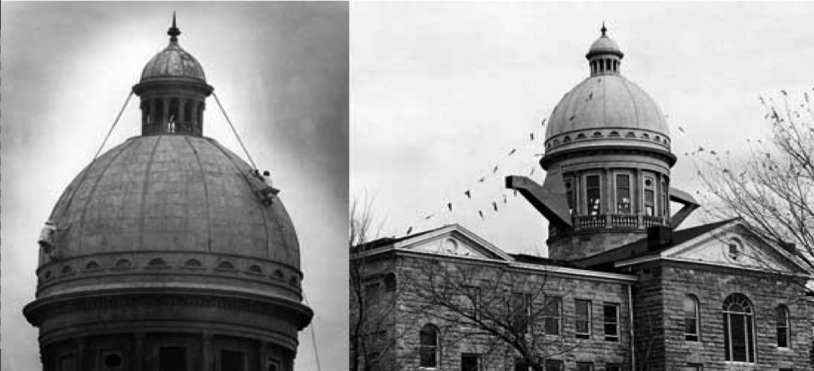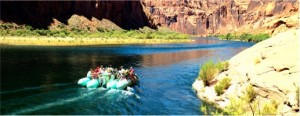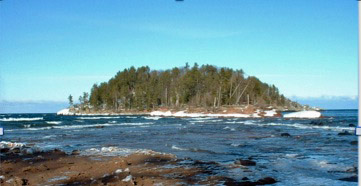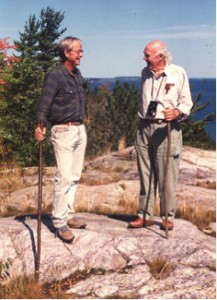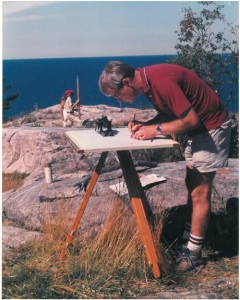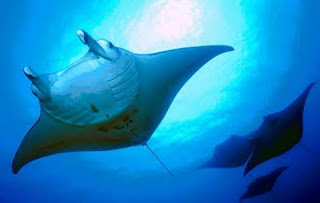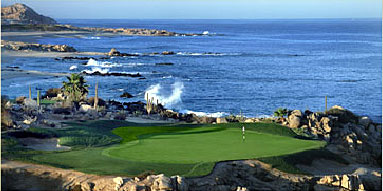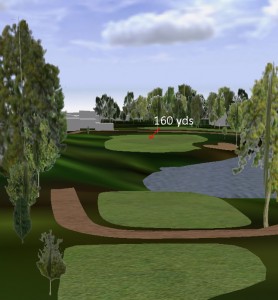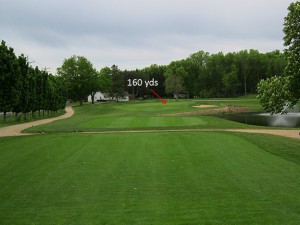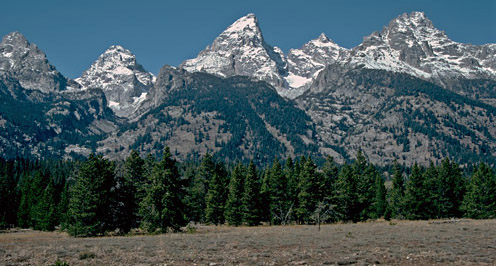 The Cathedral Group – Teton Mountains
The Cathedral Group – Teton Mountains
The next thing most like living one’s life over again seems to be a recollection of that life,
and to make that recollection as durable as possible by putting it down in writing
Benjamin Franklin
Augustana College Years
Teapot Dome was but one particularly notable feat in a long tradition of pranks known as Augustana “phrigs,” a term that likely arose from a slang expression for quickly fixing or adjusting a thing to work in a particular way. Old Main, the most easily recognizable symbol of Augustana, was always a popular target. In November 1950, for example, a group of students set up “Crazy Connie’s Used Car Lot” overnight on the lawn in front of Old Main; seven cars sported humorous for-sale signs the following morning. On another occasion, students managed to hoist an entire small car to the top of the steps at Old Main’s 7th Avenue entrance.
But no Augustana phrig impressed onlookers and made news stories quite like Teapot Dome. The mastermind of this spectacular prank was Roald Fryxell (’56), the second-oldest son of Augustana geology professor Fritiof M. Fryxell. Having been raised by an experienced mountain-climber (the elder Fryxell wrote his dissertation on the geology of the Grand Tetons and ascended every major peak in that range), Roald had participated in numerous climbs in the Rock Island area. In the middle of the night of Sunday, Nov. 13, he gathered a group of his peers to scale Old Main, then hoist the spout and handle to the top of the building and attach them to the dome. The giant teapot was meant to advertise — of course — a tea.
Teapot Dome: a great gag by a serious geologist. On Monday morning, Nov. 14, 1955, the Augustana community awoke to a strange apparition: Overnight, an enormous handle and spout had materialized on the dome of Old Main. “Teapot Dome” was an instant sensation. A few days after the incident the Augustana Observer reported, tongue-in-cheek, that “no one was exactly sure how Old Main’s dome turned into a teakettle Monday, but there were some who speculated that the Pugs and Osos were having a tea that afternoon.” The Rock Island Argus, too, attributed the prank to Augustana’s Pi Upsilon Gamma and Omicron Sigma Omicron fraternities. Text and pictures about Teapot Dome came from Augustana’s webpage : http://www.augustana.edu/x18302.xml. Stefanie Bluemle wrote the article. Check it out for more information about Roald Fryxell.
While the spout and handle were being constructed and installed I was not able to participate, as I was the night watchman and timekeeper for the company building Centennial Hall on campus. Alas, it was my buddies that pulled off the most spectacular phrig ever. The Augustana campus and Rock Island community members were not the only ones to notice Teapot Dome. The spout and handle were large enough to be visible for miles, and the incident received media attention as far away as Chicago.
College was the place that forged my career by majoring in geology. It was also where I fell in love with the very attractive and fun to be with co-ed, Carol Jayne Anderson. We married soon after graduation and she has been my strength always and especially whenever tough times buffeted our lives.
Graduate School
At Iowa University I became so impressed with the Bighorn Mountains I decided to pursue the Ph.D. My adviser, Richard Hoppin suggested a dissertation based on field mapping of the Precambrian in the Horn area of the south central Bighorn Mountains. He was responsible for finding financial support from John James Prucha of Shell Development Company. Carol and I bought a jeep and trailed it out to Buffalo, the town that became our temporary base of operations. The owner of the grocery store was a friend of Professor Hoppin. When we made our first purchase with him, he invited us for dinner and an overnight and trout fishing at a local pond. Carol shopped for some other needs and the locals, when learning where we were going, delighted in telling her stories of the dangers including an unsolved murder up there, rattlesnakes, etc. Even though it is too high for rattlesnakes (I told her). The Horn area was high in the mountains and so remote that we had to go through sixteen gates to get to our cabin. Unfortunately for my credibility we ran over a rattlesnake the first time we headed out to start the fieldwork. That was the last one we saw. Much of the Horn was in land leased for grazing by the Ramsbottoms. Two cabins were located in a small fenced in area. Irving, a hermit cowboy, who looked after the cattle, occupied one cabin. Our cabin was a ramshackle structure abandoned long ago by a failed mining outfit. We stored food in a cooler in a nearby stream. Coleman lanterns and a propane cook stove enabled night work and cooking. Carol was bravely serving as my field assistant – while I gathered measurements she recorded data in the notebook. The financial support came by mail in two-week increments so with that cash we bought enough groceries to last until the next check came. Alas, one time we exhausted our food supply and had no money left to go to town. I said to Carol, “Don’t worry, I’ll go catch us some trout.” Turns out I didn’t get a bite but when we got back to the cabin we found a bonanza on the table in the cabin. The Ramsbottoms had brought provisions for Irving and left some for us: elk steaks, potatoes, corn on the cob, other vegetables and fruit. Hallelujah!
Beartooth Mountain Adventures
Some background is necessary. While at Monmouth College it was valuable for me to cooperate with the geology department at nearby Knox College. Larry DeMott had come from Oberlin College to restart geology at Knox. In an effort to attract more students to our field of study we wrote a National Science Foundation grant proposal to start an Introductory Geology Course in the Rocky Mountains for students of the Associated Colleges of the Midwest (ACM). The first summer was funded to allow Larry and I to establish the locale for the course. My undergraduate professor at Augustana College suggested we contact Charles Bradley at Montana State University.
Fryxell and Bradley were friends since both had carried out research in the Teton Mountains. We made an appointment with Charley to seek his help in utilizing the University campus for the course. The premise of the course was to have the student work out the geologic history of the Gallatin Valley. We proposed to take them to selected outcrops where, by applying basic principles, the students could work out the story of the origin of the landscape. It is well known that one learns geology best in the field. Charley thought it was such a great idea and we hired him to be part-time instructor. This made carte blanche for us to make use of the university facilities.
During that next summer the students had nearly completed the course but one aspect of the later history of the Gallatin Valley geology had not been encountered in the field: the role of coal. In returning to the campus we, by chance saw an outcrop of coal just off the road. We always stress to our students the need to have owner’s permission before working on private land. However, in this case, we just brought the students to have a look at the coal exposure. It is important to digress at this point: Games People Play: The Psychology of Human Relationships is a 1964 book by Eric Berne. The second half of the book catalogues a series of “mind games” in which people interact through a patterned and predictable series of “transactions” which are superficially plausible (that is, they may appear normal to bystanders or even to the people involved), but which actually conceal motivations, include private significance to the parties involved, and lead to a well-defined predictable outcome, usually counterproductive. The book uses casual, often humorous phrases such as “See What You Made Me Do,” “Why Don’t You — Yes But,” and “Ain’t It Awful” as a way of briefly describing each game. In reality, the “winner” of a mind game is the person that returns to the Adult ego-state first. It turned out that the owner of the property had an extreme dislike of the University. Here he had the Dean of the University caught red-handed, not only trespassing on his property, but with an audience while he presented his tirade at the Dean. He delighted in playing the mind game: “Now I’ve got you, you son of a bitch.”
Being at Montana State University gave me the opportunity to make contact with Professor Bill McManus. We applied for another National Science Foundation grant . When it was awarded we enlisted Charley Bradley and Rolland Reid of the University of Idaho to carry out research and map the complex Precambrian crystalline rocks on the northwest ‘Livingston corner’ of the Beartooth Mountains. It was quite a logistical problem to work at the remote and high altitude of our campsite. Initially we had a wrangler and horses to carry up the tents and materials needed.
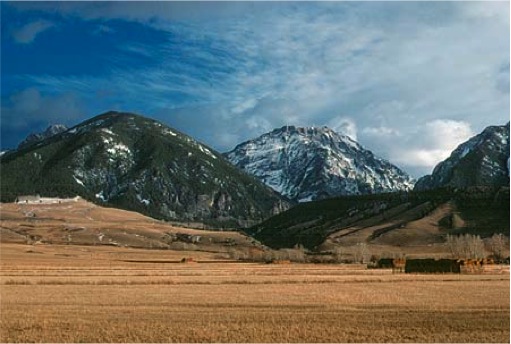 View of Pine Creek canyon from Paradise Valley – this was the point of entry for our fieldwork on the North Snowy Block
View of Pine Creek canyon from Paradise Valley – this was the point of entry for our fieldwork on the North Snowy Block
Charley Bradley was appointed as the food commissar. My assistant had worked summer jobs in Chicago with mid-morning coffee and sweet rolls and a lunch of three sandwiches. After Charley sent us out with a lunch of one can of sardines and some soda crackers to share, we had him fired! Apart from that, it was a marvelous experience in several respects. The geology and scenery were spectacular. We typically worked from our tent camp at 10,000 feet to elevations of above 11,000 feet.
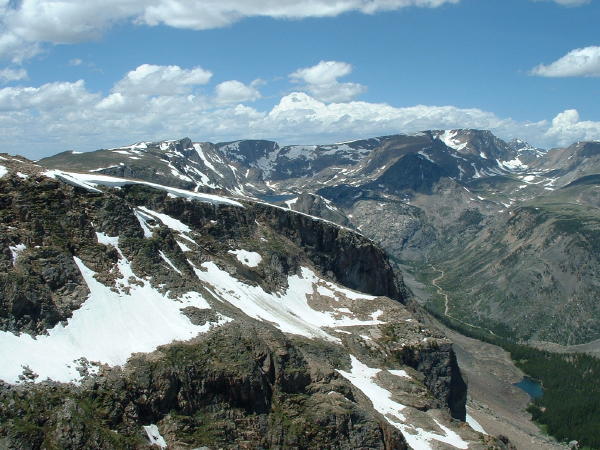 The work was published as ‘Precambrian Geology of the North Snowy Block,’ Special Paper 157 of The Geological Society of America.
The work was published as ‘Precambrian Geology of the North Snowy Block,’ Special Paper 157 of The Geological Society of America.
Close calls with disaster
I led many Spring Break field trips to Colorado. Although the stops were varied we always spent time introducing students to making geologic maps at Garden of the Gods in Colorado Springs and the Twin Mountain area of Cañon City. The work was designed to give students hands-on experience in structural mapping and stratigraphy. They also picked up some experience in contacting the local culture. Driving up the road to reach the Cañon City embayment we passed rancher Fancher’s place, the ranch where the Freak sisters lived and also Billy Dilley’s ranch. One of the Freak sisters married Billy Dilley. Their first son they named little Willy Dilley. Okay, I made up the last name but all the rest are actual names of real people.
At the end of the embayment we had the students study the formations they would be mapping by visiting well-exposed strata on the Shelf Road. The Shelf Road is aptly named: a one lane cut into a slope with the edge of the shelf dropping some thousand feet into the bottom of the embayment. If one dares to drive it, it will take you to Cripple Creek. Students had to clamber above the road to make notes describing the early Paleozoic rocks. When reaching the upper limit of study, they work back down to the Shelf Road. The slope is steep enough that when going down, to prevent falling, one will almost ‘run.’ One student while doing this, was going so fast he was unable to stop, and disappeared over the shelf. His name: Brad Powers. I panicked and immediately began mentally composing letters, one to the Dean and another to Brad’s parents. We would need help from authorities to retrieve the body. In a classic understatement, we were relieved to see Brad’s face appear sort of like ‘Kilroy’ over the edge of the road with the biggest shit-eating grin I have ever seen. He fortunately had been able to break the fall by catching a slight protrusion or miniature shelf below the road shelf.
The Lawrence University geology department celebrated the centennial year of the Powell Expedition by offering a Colorado River float trip (1969). We had three near disasters. Early along down the river, Professor Joe Kohut went swimming in his khaki pants and the current started carrying him away, Bill Trauba dove in to rescue him.
A second scare happened while passing through some rapids, the motor mount loosened and the boatman lost control of the raft. He managed to put the bow ashore and ordered the students in the front to jump out and hold the raft. They jumped out but the current swung the raft out and they were unable to hang on to it. The raft and the rest of us rotated safely through the rapids and beached downstream so, we thought, we could easily pick up the stranded students. Not so easy: they were stranded on an island. They had to jump into the fast current and be plucked out as they came floating along.
The third alarming situation took place on the climb out up the Bright Angel Trail, Professor Larry DeMott and I had to prod a couple overweight female Knox students and a high school student with a heart condition. They wanted to rest at every trail bench so we tried singing songs and using other means of encouragement to keep them going. We barely made it to the top before dark. Trauba came down the trail to assist, his second rescue. Later in life he got a geology master’s degree from Oregon State but abandoned geology and became a priest to save souls in Papua New Guinea and Mexico.
A near disaster happened during the Beartooth project. One day we worked along a ridge just across from our camp, traversing along down and around the end of the ridge and up the other side. At the end of the day we decided to go up and over to get back to camp rather than retrace our steps. It was very steep so I led the way and when I put my foot down, I asked my assistant whose head was level with my foot, “Is this solid?” He said it was, but when I put my weight on it, it broke loose and fell thousands of feet. We did make it back safely but it was precarious in a number of other places.
Another close call took place when, a few years later, I returned with a couple students to share with them the geological wonders of that Beartooth research area. We were climbing and crossing a very steep snowfield. It was a summer day and the snow was melting with water running under the snow. I didn’t see it but the students said a big boulder went flying right past my head. It must have had a precarious resting place when melting released it and gravity sent it flying down slope to a near fatal encounter with my cranium. Whew!
Natural Radiation from a mineral
While mapping in the Precambrian gneiss of the Bighorn Mountains of Wyoming I encountered an anomalous situation. A brown mineral, about the size of a fingertip, was weathered in positive relief above the surface of the rock. It was surprising that it should be resistant to erosion since it appeared to have a glassy luster. Glass, we know is unstable, and will devitrify quickly as even in old homes the windows have started to develop microcrystals. The Bighorn gneiss is around 2.6 b.y. I collected the sample for later investigation and carried it around in my pocket for quite some time.
I confirmed from the lack of an x-ray diffraction pattern that it indeed was glass. It turned out to be allanite, a mineral containing thorium. The alpha particles from the radioactive decay bombarded and destroyed the crystal structure to convert the mineral to glass. Also, the surrounding minerals were weakened by radiation tp explain the fact that the metamict allanite was more resistant to weathering than its surround. Allanite, also called orthite, contains up to 20% rare earth elements and is a valuable source of them. Other elements can also substitute in the structure including thorium.
Thorium is a chemical element with the symbol Th and atomic number 90. As a naturally occurring, slightly radioactive metal, it is considered to be an alternative nuclear fuel to uranium. The inclusion of thorium and other radioactive elements results in some interesting phenomena. Allanite often has a halo of radiation damage in the minerals immediately adjacent. Also highly radioactive grains of allanite often have their structure disrupted or are metamict.
I wondered about the possibility of radiation damage to my sperm while I carried the allanite in my pocket. Fortunately our three children had already been born.
Not quite a disaster
Our family has spent at least some part of most summers at our cabins on the shore of Lake Superior. Since we arrived in Appleton I oftem used the cabins to house students on our geology department spring and fall field trips. The area has about the best and most varied examples of geological features of any area of equal size that I know of world- wide. Our property is on a beach southeast of Marquette. Northwest of Marquette the shore has glacially smoothed and wave-washed crystalline rock exposures. These rocks reveal complex histories in small areas that are ideal for my students to map and complete petrographic work back on campus. Many students have done Honors projects on these areas I have identified. It was my pleasure to hike along the shoreline to seek out such areas. The coast is mostly undeveloped and has that rugged rocky shore backed by beautiful old growth White and Norway pines so it was a delight to spend some hot summer days seeking appropriate study areas.
One such day I was doing just that, and yes, it really does occasionally get hot and humid in the U.P. So I decided to strip off all my clothes and jump off the rocks into the deep water. Alas, it doesn’t take Lake Superior long to cool one off. In fact, my genitals were already withdrawing when I noticed a motorboat with about half a dozen black-robed nuns aboard heading directly toward me. It turns out that Villa St. Joseph, a Catholic retreat house, was nearby and apparently a parishioner had decided to take the sisters out for a relaxing boat ride. I’m sure they never knew anyone was near the shore but the boat was most likely heading for the top of Sugar Loaf Mountain and I just happened to be on a line in between the boat and Sugar Loaf. Soon, fortunately, they turned off and I was able to dry in the sun and proceed on my quest for new study areas.
Another Superior Shrinkage Story
My first job after finishing at Iowa was with the California Company (Chevron). Exploring for petroleum was not my cup of tea, but at the time I had few other options. The office was right downtown so car pooling was the standard operating procedure. I soon joined a car pool with others who lived in the same Metarie neighborhood. While getting acquainted and sharing our personal backgrounds, I happened to mention something about having lived in Marquette, Michigan. One of the riders, a geophysicist, had taken his field course from Michigan State. It was based at Northern Michigan University in Marquette. He told how one of the field studies was on Little Presque Isle and they had to wade in waist deep water to get to their mapping area.
He said the water was really cold. “How cold was it,?” The answer – “It was so cold, when we got there the only guy that could find his penis was a fellow named Tripod Johnson.”
Encounters with famous people
At the University of Iowa I was inducted into, Sigma Xi, The Scientific Research Society. As part of the ceremony, Professor James Van Allen shook my hand. It was quite a thrill be so close to the physicist who made the first major scientific discovery of the early space age, the radiation belts that bear his name.
At Monmouth College I had the privilege of putting the hood around the neck of Buckminster Fuller at the graduation exercises. Fuller published more than 30 books, inventing and popularizing terms such as “Spaceship Earth”, ephemeralization, and synergenetic. He also developed numerous inventions, mainly architectural designs, including the widely known geodesic dome.
A chance meeting with Hubert Humphrey took place at the Minneapolis airport following the Democratic convention in Chicago. Humphrey and his running mate, Ed Muskie easily won the Democratic nomination at the party’s 1968 convention. Unfortunately for Humphrey and his campaign, outside the convention hall there were riots and protests by thousands of antiwar demonstrators, many of whom favored “anti-war” candidates. These protesters – most of them young college students – were attacked and beaten on live television by Chicago police. The protesters had scruffy beards and sloppy clothing. Following the convention Humphrey returned to the Minneapolis airport at the commuter terminal where I had just arrived in transit from living in the mountains doing research in the Beartooths. Months in the mountain left me with a scruffy beard and clothing gave me the look of a protestor. Humphrey was glad-handing and pausing while greeting his well wishers. Most of them were Minnesotans from places that Humphrey had many friends and supporters. He would mention names and chat amiably. However, when he came to shake my hand, he was very quick and cursory. No doubt owing to my scruffy appearance, he feared that I was one of the protestors. When I got off the plane in Appleton, daughter Kirsten was actually kind of frightened by my appearance.
Upon leaving Papua New Guinea I had to visit the currency exchange. After I had exchanged the PNG Kina for currency of our next country, Australia, I was idly viewing a travel poster showing a scuba diver with a chambered nautilus in each hand. I knew from my paleontology class that these cephalopods had changed little from Paleozoic times and that they had jet propulsion for fast swimming. I said, to no one in particular, “I doubt that a diver could catch them like the poster suggested. Cephalopods swim too fast.” A guy dressed in classy tourist attire said, “What’s a cephalopod?” After I explained, we continued to have a conversation about PNG. I was talking like a seasoned visitor, just departing to a first timer in the country. I suggested that the Missionary Guest Houses were clean, safe and inexpensive places to stay. A very attractive woman joined him and we went our separate ways. Imagine my chagrin when on boarding the plane to leave we learned that Harry Hamlin and Nicolette Sheridan were the couple that had just arrived. No doubt these Hollywood stars were joining one of the pricey guided tours and had no need to save money.
Nina Leopold and Charles Bradley were friends back in the 1930’s when their fathers were on the University of Wisconsin faculty. Aldo Leopold is famous for more than writing ‘Sand County Almanac.’ He was an author, scientist, ecologist, forester and environmentalist. When Charlie’s wife died he remarried to Nina. They built their retirement home on the grounds of the Aldo Leopold Shack and Farm, a historic site in Baraboo, Wisconsin. The home was built using logs from trees that Nina and her father had planted on the property. Carol and I were guests in that home and used their Swedish composting toilet. We were thrilled to be taken on a hike to see the famous shack. Later, when the Lawrence University Freshman Studies course included ‘Sand County Almanac’ I arranged for Nina to come and give a lecture. Also, Charlie Bradley spoke to the geology department on his snow avalanche research. Bradley was known for his wry humor. On final exams, he included such questions as “Each earthquake belt is accompanied by a buckle, true or false,” and “Extra credit: Discuss the universe in general, be specific, give two examples.”
While living in Chicago I saw lots of Cubs games in Wrigley Field, including the year they won the pennant. That would by 1945. On May 18, 1947: Jackie Robinson makes his Chicago debut before largest single-game paid attendance in Wrigley Field history (46,572), but Dodgers beat Cubs 4-2. Dad and I were there. Another memorable event was the day I went with some buddies to a Cardinal game and I went to the Cardinals dugout. I talked with Stan Musial and got his autograph. He was very friendly.
I met another baseball star right here at home. Tony Kubek, is an Appleton resident. He is ranked no. 3 in a list of top ten Yankee shortstops after Derek Jeter, no. 1 and Phil Rizzuto , no. 2. He was AL Rookie of the Year in 1957, and an All-Star in ’58, ’59 and ’61. He won 7 Pennants (1957, ’58, ’60, ’61, ’62, ’63 and ’64) and 3 World Series (1958, ’61 and ’62). A back injury forced him to retire in 1965, not even 30 years old. He went into broadcasting and was one of NBC’s main baseball voices, paired with Joe Garagiola in the 1970s and Bob Costas in the ’80s. I happened to meet him when visiting the Bob Burns Golf Shop. When I walked in, Bob Burns greeted me by name. At once, another customer asked me if I knew Donovan Palmquist. I said, “Yes, I know him and his wife Dottie because she and I were both students at Augustana College.” Turned out that the Kubeks and the Palmquists were friends at the northern Wisconsin lake where they had summer cabins. I said, Donovan and Dottie had gone to Arizona for the winter. Tony said, “I went south too, to Appleton. “
In the 1950s one of my favorite bands was the Stan Kenton orchestra. When they performed at the Trianon in Chicago I went and during one of the breaks, I went up and had a short conversation with Stan Kenton.
When John Updike gave a Convocation lecture at Lawrence, Rik Warch encouraged Carol to go up and get his autograph. I went with her for moral support. When he wrote it in her name, he said, “Is that Carol with or without the e?” Later he she got one of his books from the library autographed. In his talk, he mentioned being a fallen away Lutheran. At the second signing Carol told him she wasn’t a fallen away Lutheran.
At another Lawrence Convocation I was at a luncheon and visited with Stephen Jay Gould.
Our college friend, Alan Swanson married a woman from Centerville, Iowa who was a school chum of a guy named Simon Estes. At the University of Iowa Simon was the only African-American in the ‘Old Gold Singers.’ When the director told Simon he should consider opera, Simon said, “ What’s opera?” He did and became a world-class opera star. Al and Mary have been close friends of Simon and they spent lots of time together. Mary wrote and published his biography. Early in my retirement, Al and I took a trip to Europe. We were met at the Zurich airport by Simon and went to lunch at his home. Our trip included outstanding sites in Switzerland, Austria, Hungary and Italy but especially memorable was the visit to the opera in Vienna. Simon had reserved seats for us. He had the role of Escamillo in Georges Bizet’s Carmen (March 9,1997).
During his 30-year career, Estes has sung more than 95 classic bass-baritone roles, among them Bizet’s Carmen, Rossini’s Boris Godunov and Gershwin’s Porgy in “Porgy and Bess,” while performing with all of the world’s major opera companies, including the Metropolitan, Paris, Munich, Vienna and San Francisco operas. At my suggestion Lawrence University honored Simon Estes with an honorary doctor of fine arts degree at the 1998 commencement. He wowed the graduates by singing ‘Climb Every Mountain.
In connection with the property owned by Bill Savola (see below), I had an opportunity to become acquainted with John Lautner. John Lautner designed over 200 architectural projects during his career, but many designs for larger buildings were never realized. His work consisted mostly of his domestic commissions, although he designed numerous commercial buildings. His buildings have been the subject of numerous exhibitions in the United States and abroad. His works have been featured in countless publications, in a documentary film on his life and work, in the James Bond and Diehard films, among others, and in commercials for television.
His distinctive application of the principles of organic architecture was, of course, profoundly influenced by his apprenticeship under Frank Lloyd Wright in Taliesin West.
Lautner was born in Marquette and, on one of his returns to his hometown, Bill Savola managed to convince him to come and inspect his property. Lautner came up on the rock, not inhibited by his advanced age, and pronounced it ‘marvelous.’
Because I had made a description of the geology of the property (it is cast in brass and on display at the tourist welcome center across the highway from the property) he asked me to help him get a brass casting for his family cabin (Midgaard) out at Middle Island Point. He invited Carol and me for lunch at his cabin. He wrote up a legal sounding document intending to ensure that the cabin would in perpetuity belong to the family. I had it cast in bronze back in Appleton and it is now affixed to the cabin.
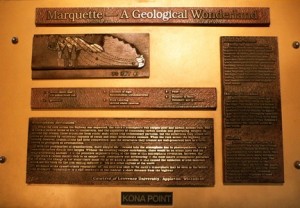 For more on Lautner, check out:
For more on Lautner, check out:
http://www.hsmichigan.org/wp-content/uploads/2012/06/JulyAug_Lautner.pdf
Adventures with Bill Savola My association with Bill Savola, a boyhood friend in Marquette, was expanded when he purchased a large tract of property with a view of Marquette harbor. Bill had spent most of his career in the Detroit environs, teaching in public schools and building impressive orchestra conducting credentials. Upon retirement he worked in the offices of Continental airlines in exchange for airline miles. We were reconnected when Fred Rydholm suggested to Bill that I might be useful in connection with developing his property. Much of the property is underlain by quartzite and obtaining water was one of the problems that needed a solution before residential development. My brother Will and I mapped the quartzite bluff where Bill hoped to build his retirement home.
Bill had been in the Army symphony orchestra and traveled over much of Europe while in the service. Later he spent most of his summer vacations traveling the rest of the world. When he asked if I would like to visit Papua New Guinea with him I readily agreed. It was a fabulous way for me use my spring term sabbatical to expand my geological experiences in the ‘Ring of Fire.’ The trip included Hawaii, Pacific Island via Air Micronesia stops on several islands (Johnston, Majuro, Kwajalein, Kosrae, Pohnpei, Truk, Guam, Yap and Palau), Papua New Guinea, Australia and New Zealand.
In addition to scuba diving on world-class diving sites, I particularly enjoyed snorkeling in Jellyfish Lake on Palau. I had once seen a Jellyfish Lake video on PBS or the National Geographic channel. While on our Papua New Guinea venture we stopped at several Pacific islands, including dive sites on Yap (manta rays), Truk (sunken Japanese ship and coral wall) and Palau. To my delight and surprise after a coral wall dive we snorkeled in the very lake I had seen on TV and never dreamed I would ever see for myself. The jellyfish were trapped in this lake after a submerged reef rose from the sea, creating a landlocked saltwater lake.
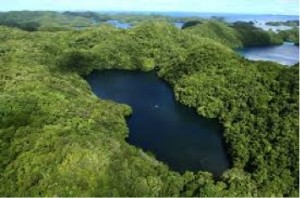 In this lake, the jellyfish have adapted to the new conditions by losing their sting (nematocysts). They have eight primitive eyes and algae that live within their cells. These algae are what the jellyfish live on. Twice each day, the jellyfish in the lake swim from one side to the other. The jellyfish do this to get sunlight to their internal algae so that the algae can grow. At night the jellyfish swim to a lower depth where the water is rich in nitrogen. The nitrogen also sustains the algae population. The jellyfish has only one main predator in this lake — the sea anemone. Jellyfish can be stung, trapped, and killed by these creatures.
In this lake, the jellyfish have adapted to the new conditions by losing their sting (nematocysts). They have eight primitive eyes and algae that live within their cells. These algae are what the jellyfish live on. Twice each day, the jellyfish in the lake swim from one side to the other. The jellyfish do this to get sunlight to their internal algae so that the algae can grow. At night the jellyfish swim to a lower depth where the water is rich in nitrogen. The nitrogen also sustains the algae population. The jellyfish has only one main predator in this lake — the sea anemone. Jellyfish can be stung, trapped, and killed by these creatures.
Our first stop in the Highlands of Papua New Guinea was at a resort in Mt. Haugen that was owned by two women. One woman was an English woman who had married a man from New Guinea. The other woman was the daughter of a woman who became pregnant by an Australian explorer. In 1930, when the Leahy brothers penetrated the interior of New Guinea in search of gold, they carried a movie camera. Thus they captured on film their unexpected confrontation with thousands of Stone Age people who had no concept of human life beyond their valleys. This amazing footage forms the basis of First Contact. Yet there is more to this extraordinary film than the footage that was recovered. Fifty years later some of the participants are still alive and vividly recall their unique experience. The Papuans tell how they thought the white men were their ancestors, bleached by the sun and returned from the dead. They were amazed at the artifacts of 20th century life such as tin cans, phonographs and airplanes. We were able to see a copy of the First Contact video at the resort and were introduced to the mother of the co-owner. Thus, I met a living Stone Age woman in 1992! Among many PNG adventures, I will relate how we disarmed a ‘munitions dealer.’ Road transport varied from small vans to open trucks with benches on concrete blocks with capability to throw tarpaulins over a crude frame to protect from the elements. In Wabag we boarded a truck, and began communicating with a young man who had an elongate ‘package’ covered with green leaves. We learned he had two bows and arrows that he was taking to an area where there were tribal wars. Indeed, on another day we had seen a single file group of warriors armed with bows and arrows on their way to a battle. We bargained with the fellow and bought the package. We thus save some lives, and saved the fellow a journey.
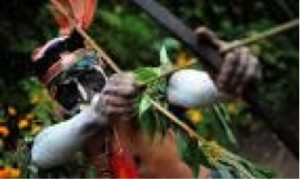 On another trip we were crossing a ‘provincial’ boundary. There were armed men who stopped our bus and ordered every one out. We had heard that there were instances of road agents that would stop vans/buses and take everything including clothes from the passengers and send them unharmed but naked to the next town. We thought, ‘This is it.’ In fact, they looked at Bill and I, the only white people on the bus, and said, “Not you masta,” and let us stay on the bus. They were looking to prevent liquor and firearms from getting into their ‘province.’ Cultural aside, I sort of enjoyed being called ‘massa’ or master, a relic from the time the Australians came into the country. Also, though pickaninny is an offensive term for a black child, in Papua New Guinea it is routinely used. People often asked me if I had any pickaninnies.
On another trip we were crossing a ‘provincial’ boundary. There were armed men who stopped our bus and ordered every one out. We had heard that there were instances of road agents that would stop vans/buses and take everything including clothes from the passengers and send them unharmed but naked to the next town. We thought, ‘This is it.’ In fact, they looked at Bill and I, the only white people on the bus, and said, “Not you masta,” and let us stay on the bus. They were looking to prevent liquor and firearms from getting into their ‘province.’ Cultural aside, I sort of enjoyed being called ‘massa’ or master, a relic from the time the Australians came into the country. Also, though pickaninny is an offensive term for a black child, in Papua New Guinea it is routinely used. People often asked me if I had any pickaninnies.
We went on to Eastern Australia and New Zealand before returning home. Along the way we met tourists who raved about the wonders of Bali. So in 1994 I had another sabbatical and we went to Indonesia for another grand tour. We made extended stays in Bali, Lombok and East Java.
Golf Story
On occasion I go to the golf course as a single player. Since golfers tend to be very fine folks, I have met a great many nice, friendly people. The most unbelievable encounter occurred at Denver’s City Park Golf Course one late winter day. I was paired with a gentleman named John Carlson. As we walked down the number one fairway, we indulged in typical small talk. When he found out I was visiting from Wisconsin, he commented on the heavy snows ‘back there.’ When I said that our Wisconsin winter had not been that bad, he countered that his brother in Illinois had complained about having enormous amounts of snow to shovel. I asked, “where in Illinois.” He replied “Moline.” (Golfers will know of the Quad Cities Open but may not know that Moline, East Moline, Rock Island, and Davenport are the Quad Cities.) Next I told him that I had gone to Augustana College in Rock Island. John knew a lot about that college including the name of the President when I graduated in 1956 (Dr. Conrad Bergendoff, who was still living at 101 years of age!) Pursuing these connections I asked this Denver resident where he was born and raised. He replied, Cambridge, Illinois. I then said that my mother’s family was from that part of western Illinois, and my grandfather had owned Anderson Lumber Yard. Oh, yeah. He knew Woodhull and even remembered the lumberyard for sure. I went on, telling him that my grandmother’s maiden name was Westerlund, and my Great Uncle, Peter Westerlund had embarked with some friends and a team of oxen and a wagon to seek gold in the Pikes Peak area of Colorado. They found no gold but had many exciting times. After selling their wagon and team they floated the Rio Grande and ended up in Texas. Their adventures were published and recorded in a Henry County Genealogy volume. They saw the first house as it was being built in Denver. John Carlson had read about that so he knew that story too. This was beginning to be really amazing but it became even more so when it turned out that he was delivered by Peter Westerlund’s son, Dr. John Westerlund. He even recalled how, in those days, Doc Westerlund would travel by horse-drawn sleigh to answer house calls in a blizzard. Now this small world story became even more remarkable when, waiting to join us at the fourth tee. was a man who had dropped out of his group and asked to play along with us. His original home was Gwinn, Michigan. This very small town is a short distance from where I lived in Michigan’s upper peninsula, the Queen City of the north, Marquette. Indeed, it is a small world after all.
Golf has been a persistent challenge and source of much happiness. Especially memorable outings include playing with Kirsten at some famous courses. Cabo del Sol Golf Club – Ocean Course, designed by Jack Nicklaus (“three finest finishing holes in all of golf”) and Cabo del Sol Golf Club – Desert Course designed by Tom Weiskopf. We also played a course at the Phoenician in Scottsdale. I must also mention the special outings with friends at Greywalls in Marquette and TimberStone at Pine Mountain in Iron Mountain, MI. After retiring, I played over one hundred rounds annually at the neighborhood course, Reid Municipal Golf Course. It was a short walk from home so I walked to the course and played, pushing my Sun Mountain golf cart.
Golf High Lights
Playing at faraway courses:
Stellenbosch Golf Club, near Cape Town, South Africa.
Cabo del Sol, Mexico – Ocean course (Nicklaus)
The Phoenician, Scottsdale, AZ.
Favorite courses closer to home: Timberstone, Iron Mountain, MI and
Two Lucky Days
- September 9, 2003 – I made a hole-in-one on the 160 yard eleventh hole at Reid Golf Course
- Some 10 years later, I shot 78 when I was 79 years of age at Irish Waters
